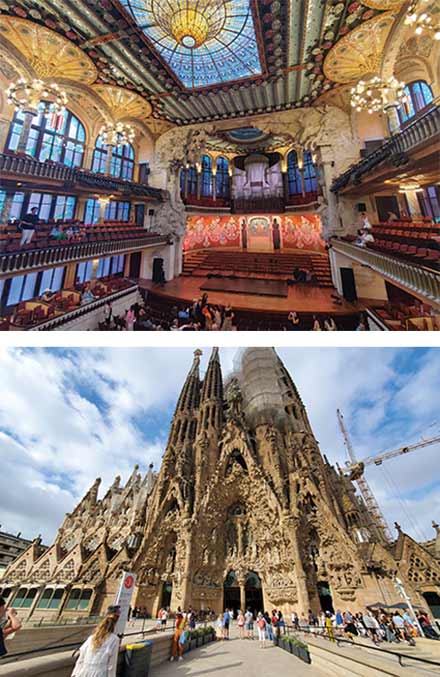
By Sandra Marsian
Former Vice President, Travel, Marketing & Membership for AAA Pioneer Valley
My short rendezvous to Barcelona preceded a Mediterranean cruise vacation with my sister and niece, allowing us a brief but rich experience in this inspirational city. To better understand its depth, the Barcelona Region, one of 17 autonomous regions of Spain, is the capital of Catalonia and is comprised of 10 districts, each divided into distinct neighborhoods. Barcelona’s excellent public transportation system furthers its appeal to travelers worldwide. Considering our time constraints, we opted for taxis and our own two feet, spending most of our time in the oldest part of Barcelona in both the Ciutat Vella (Old City) district and the Eixample district. Ciutat Vella is comprised of four smaller neighborhoods including The Gothic Quarter, El Raval, Barceloneta and La Ribera/El Born. The Eixample district is home to upscale residences, stores, and the works of Antoni Gaudi.
A stroll along Las Ramblas, the Old City’s major boulevard, was an excellent way to begin our visit as it joins the city center with the sea, dividing the Gothic Quarter from El Raval. The Arabic origin of the street’s name is fitting, meaning sandy riverbed because that is just what Las Ramblas once was, laying just outside the Gothic Quarters wall. Today it is a lively palm tree lined avenue dotted with outdoor café’s, shops, restaurants, street performers and the like. Days could be spent wandering the streets of both neighborhoods, or Barri’s as they are called, as each area has its own unique vibe. El Raval is a bit edgier, known for its street art, The Contemporary Art Museum of Barcelona and The Boqueria Market for produce both today and in the Roman times. The Gothic Quarter is home to medieval monuments, grand churches and its winding narrow cobblestone streets. We enjoyed wandering without aim, popping into quaint pastry shops for coffee and a baked treat, shopping for art from local folks in an outdoor square and stumbling upon sidewalk vendors selling old book and antiques.
For dinner, a friend and frequenter of Barcelona suggested Casa Lolea for amazing homemade Sangria and delicious tapas. Knowing it was a smaller venue, we wisely made advanced reservations as this spot was clearly popular with the locals. The white and red Sangrias were deliciously refreshing at a mere $6 euro a glass. A perfect way to relax after a long, hot day of city walking. Our delectable local fare included Pasta Risotto with Black Truffles, Octopus Ceviche, acorn fed Iberian ham, Manchego cheese and Kalamata, Bola and Gordal olives. A perfect prelude before our evening entertainment right around the corner. Casalolea.com for details and reservations.
My companions especially requested that we attend a Flamenco dance performance. The Palau de la Música Catalana (Palace of Catalon Music), is one of the most famous concert halls in the world, considered a beacon of Catalan modernist architecture and declared a Word Heritage Site by UNESCO so it seemed necessary that our first Flamenco performance be experienced here. Built between 1905 and 1908 by architect Lluis Domènech i Montaner, this magnificent, colorful theater is reason enough for a visit. The show was comprised of three renowned guitarists, maestros Alí Arango, Xavier Coll and Luis Robisco, paired with amazingly talentedflamenco dancers from Spain, all delivering a passionate tribute to Flamenco and Catalon music. Their palpable passion for their craft was contagious and made for a memorable evening that we won’t soon forget. Ticket prices start at around $39 euros at www.palaumusica.cat.
First exposed to the architecture of Antonio Gaudi during a grade school project, I always found his Catalan Modernistic designs fascinating and when in Barcelona, a peek at some of his renowned designs are a must. He believed that since there were no straight lines in nature there should be no straight lines in his designs during his gothic naturalism phase. Gaudi’s design of Casa Batlló, a personal favorite, is a perfect example of his beliefs as the windows were elongated, entryways curved, and ceilings undulated. A colorful mosaic made of broken ceramic tiles cover the exterior of this home adding to its eye-catching façade and it is yet another UNESCO World Heritage Site to be enjoyed. Gaudi’s works, easily recognizable, can be toured for a fee. Consider taking a tour led by practicing architects through Gaudi’s residential building designs including Casa Calvet, Casa Milà and of course Casa Batlló. Park Guell is a Barcelona public park where Gaudi’s genius touches everything from sculptures to gardens. Gaudi designed many homes and public spaces in the late 1800s but his crowning jewel would be Sagrada Familia, the magnificent Roman Catholic Basilica in Barcelona that earned him the nickname “God’s architect.” An extremely religious man, Gaudi once said “The expiatory church of La Sagrada Familia is made by the people and is mirrored in them. It is a work that is in the hands of God and the will of the people.” Having passed away in 1926 his words echo the truth even more so today, given that his most famous design is still under development and has no firm completion date in sight. The constant construction is funded by admission fees, so the will of the people is clear as they continue to fulfill Gaudi’s vision 141 years later. This awe-inspiring work of architecture gives us excuse to visit Barcelona again and again. Review ticket options at www.sagradafamiliatickets.org.
Each return visit to Barcelona feels like my first and it always leaves me wanting to return.
The way old meets new and the unique blend of Spanish and Catalan culture has a magical influence on the city’s art, music, dance, architecture, food, drink and people making it worthy of a much longer stay.